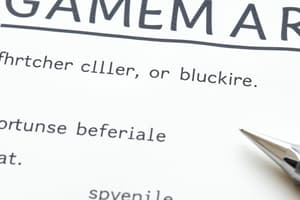Podcast
Questions and Answers
What is the primary function of conjunctions in a sentence?
What is the primary function of conjunctions in a sentence?
- To specify the tense of the verb
- To connect words, phrases, or clauses (correct)
- To define the parts of speech
- To indicate the subject of the sentence
Which of the following is a characteristic of English sentence structure?
Which of the following is a characteristic of English sentence structure?
- Always begins with a verb
- Follows a Subject-Verb-Object (SVO) format (correct)
- Uses a fixed order that cannot change
- Contains clauses that do not relate to a subject
What aspect does English grammar NOT govern?
What aspect does English grammar NOT govern?
- Formation of a sentence
- Subject-verb agreement
- Use of punctuation marks (correct)
- Tense of verbs
Why is vocabulary acquisition important?
Why is vocabulary acquisition important?
Which statement about English dialects is true?
Which statement about English dialects is true?
What type of language is English classified as?
What type of language is English classified as?
Which of the following is NOT a type of noun?
Which of the following is NOT a type of noun?
What is the primary function of pronouns in English?
What is the primary function of pronouns in English?
Which of the following describes the function of adverbs?
Which of the following describes the function of adverbs?
Which sentence correctly illustrates the use of a preposition?
Which sentence correctly illustrates the use of a preposition?
Which type of verb indicates a state of being?
Which type of verb indicates a state of being?
What are adjectives primarily used for in a sentence?
What are adjectives primarily used for in a sentence?
Which option does NOT represent a part of speech in English?
Which option does NOT represent a part of speech in English?
Flashcards
Conjunctions
Conjunctions
They connect words, phrases, or clauses in a sentence and show the relationship between them.
Sentence Structure
Sentence Structure
Many English sentences follow the order of Subject-Verb-Object (SVO).
English Grammar
English Grammar
Grammar explains the rules for forming and using sentences, including subject-verb agreement, tenses, and parts of speech.
Vocabulary
Vocabulary
Signup and view all the flashcards
Punctuation
Punctuation
Signup and view all the flashcards
What is the origin and structure of the English language?
What is the origin and structure of the English language?
Signup and view all the flashcards
What are nouns and their types?
What are nouns and their types?
Signup and view all the flashcards
What are pronouns and their types?
What are pronouns and their types?
Signup and view all the flashcards
What do verbs express?
What do verbs express?
Signup and view all the flashcards
What are adjectives and their function?
What are adjectives and their function?
Signup and view all the flashcards
What are adverbs and their function?
What are adverbs and their function?
Signup and view all the flashcards
What are prepositions and their function?
What are prepositions and their function?
Signup and view all the flashcards
What are conjunctions and their function?
What are conjunctions and their function?
Signup and view all the flashcards
Study Notes
Basic Structure of English
- English is an Indo-European language.
- It is a West Germanic language that originated in England.
- It has a complex grammatical structure, containing a subject, verb, and object, with various sentence structures and variations.
Parts of Speech
- English has several parts of speech, including nouns, verbs, adjectives, adverbs, pronouns, prepositions, conjunctions, and interjections.
- Each part of speech has specific grammatical roles and functions within the language.
Noun
- Nouns are words that identify people, places, things, or ideas.
- Types of nouns include common nouns (e.g., dog, tree), proper nouns (e.g., London, Mount Everest), abstract nouns (e.g., happiness, freedom), and concrete nouns (e.g., book, table).
- Nouns have different grammatical functions within sentences (e.g., subject, object, complement).
Pronoun
- Pronouns replace nouns. They avoid repeating the same noun.
- Various types of pronouns include personal pronouns (she, you, they), possessive pronouns (hers, ours, theirs), demonstrative pronouns (this, that, these, those), interrogative pronouns (who, what, which), relative pronouns (who, whom, whose, which, that), and indefinite pronouns (each, every, anybody).
- Pronouns highlight relationships between words in a sentence.
Verb
- Verbs express action, state of being, or occurrence.
- Verbs describe what the subject does, is, or has.
- Verbs can also show mood or tense, adding detail.
- English employs various verb tenses (e.g., present, past, future, perfect, progressive) to show time relationships.
Adjectives
- Adjectives modify nouns and pronouns.
- They describe or give more detail about the noun or pronoun.
- Example: "The red car" (red modifies car).
Adverbs
- Adverbs modify verbs, adjectives, or other adverbs.
- They show manner, time, place, frequency, degree, etc.
- Example: "She ran quickly." (quickly modifies ran).
Prepositions
- Prepositions show the relationship of a noun or pronoun to another word in a sentence.
- They show position, time, direction, and other connections.
- Common prepositions include "on," "in," "at," "to," "from."
- Example: "The book on the table." (on shows the book's relation); "She went to the store." (to shows the direction).
Conjunctions
- Conjunctions connect words, phrases, or clauses in a sentence.
- They show the relationship between words and phrases.
- Main types are coordinating conjunctions (and, but, or, nor, for, so, yet) and subordinate conjunctions (because, although, if, while, since).
Sentence Structure
- English sentences follow a Subject-Verb-Object (SVO) structure in many cases.
- Variations on this structure exist (e.g., questions, passive voice).
- Knowledge of basic sentence structure aids in understanding and constructing correct English sentences.
Grammar
- English grammar describes the rules that govern the formation and use of a sentence.
- This includes subject-verb agreement, tense, and use of different parts of speech.
Vocabulary
- English vocabulary encompasses a large number of words.
- Vocabulary acquisition is crucial for effective communication.
- Different fields employ unique specialized vocabulary (technical language).
- Understanding the meanings and usage of different words is important.
Punctuation
- Punctuation marks organize and clarify written English.
- Using appropriate punctuation is important for clarity and readability.
- Different punctuation marks (commas, periods, question marks, exclamation marks, etc.) serve various grammatical purposes.
Spelling
- English uses an alphabetic writing system.
- Spelling conventions are an integral part of the language.
- Mastering spelling is necessary for writing accurately.
Dialects
- English has many dialects and varieties around the world.
- These variations impact vocabulary, pronunciation, and grammar.
- Understanding these differences is important for communication in different contexts.
Studying That Suits You
Use AI to generate personalized quizzes and flashcards to suit your learning preferences.




